The Felling of Hung Up Trees—A Work Safety and Productivity Issue
Abstract
:1. Introduction
2. Materials and Methods
2.1. Research Venue
2.2. Equipment Used in the Felling of Hung Up Trees
2.3. Field Data Collection
2.4. Data Analysis
- -
- n is the minimum number of felled hung up trees;
- -
- u = 1.96—standard deviation of normal distribution, corresponding to the transgression probability α = 5%;
- -
- s% = 11.21%—variation coefficient of the total working time taken by the felling of hung up trees. It was determined experimentally based on the measures made for the first 10 hung up trees that were felled;
- -
- Δ = ± 10%—limit error;
- -
- N = 98—estimated number of hung up trees in the felling area.
3. Results and Discussion
- -
- 3.782 m3·h−1 or 3.477 trees·h−1 (volume of the average tree was 1.088 m3) for trees that needed no repositioning of the TL;
- -
- 2.422 m3·h−1 or 2.068 trees·h−1 (volume of the average tree was 1.171 m3) for trees that needed the TL to be repositioned once;
- -
- 2.552 m3·h−1 or 1.402 trees·h−1 (tree volume was 1.820 m3) for the one tree that needed the TL to be repositioned twice. WT structure according to time elements is presented in Figure 5.
4. Conclusions
Author Contributions
Funding
Acknowledgments
Conflicts of Interest
References
- Ciubotaru, A. Exploatarea Pădurilor; Editura Lux Libris: Braşov, Romania, 1998; p. 351. ISBN 973-9240-73-9. [Google Scholar]
- Câmpu, V.R. Ghidul Utilizatorilor de Ferăstraie Mecanice; Editura Universității Transilvania din Brașov: Brașov, Romania, 2018; p. 145. ISBN 978-606-19-0988-9. [Google Scholar]
- Forskningsstiftelsen Skogsarbeten. Swedish Forestry Techniques with Possible Applications in the Third World; The Forest Operations Institute, Tryckeri AB Primo: Oskarshamn, Sweden, 1983; p. 342. ISBN 91-7614-040-7. [Google Scholar]
- ARMEF; CTBA; IDF. Manuel D’exploitation Forestière; FTBA: Paris, France, 1993; p. 442. ISBN 2-85684-013-2. [Google Scholar]
- ILO. Safety and Health in Forestry Work: An ILO Code of Practice; International Labour Office Geneva: Geneva, Switzerland, 1998; p. 116. ISBN 92-2-110826-0. [Google Scholar]
- Moș, A. Instrucțiuni Privind Folosirea Palanului cu Angrenaje la Dezaninarea Arborilor; Editura Tehnică București: București, Romania, 1957; p. 23. [Google Scholar]
- Iftimie, M.D. Riscurile resursei umane din cadrul Direcției Silvice Bacău. Ph.D. Thesis, Transilvania University of Brașov, Brașov, Romania, 2020; p. 263. [Google Scholar]
- Peters, P.A. Chainsaw felling fatal accidents. Trans. ASAE 1991, 34, 2600–2608. [Google Scholar] [CrossRef]
- Eurostat. Annual Work Units in Forestry and Logging. Available online: https://appsso.eurostat.ec.europa.eu/nui/submitViewTableAction.do (accessed on 18 July 2020).
- INS, Institutul Național de Statistică (National Institute of Statistics). Baza de Date Statistice Tempo-Online. Available online: http://statistici.insse.ro:8077/tempo-online/#/pages/tables/insse-table (accessed on 27 May 2020).
- ASFOR. Accidentele de muncă în silvicultură și în exploatările forestiere. Meridiane For. 2019, 6, 49. [Google Scholar]
- Câmpu, V.R. Calificarea fasonatorilor mecanici, o problemă de actualitate a sectorului forestier din România. Rev. Silvic. Cineg. 2019, 44, 98–102. [Google Scholar]
- Klun, J.; Medved, M. Fatal accidents in forestry in some European countries. Croat. J. For. Eng. 2007, 28, 55–62. [Google Scholar]
- Newman, S.M.; Keefe, R.F.; Brooks, R.H.; Ahonen, E.Q.; Wempe, A.M. Human Factors Affecting Logging Injury Incidents in Idaho and the Potential for Real-Time Location-Sharing Technology to Improve Safety. Safety 2018, 4, 43. [Google Scholar] [CrossRef] [Green Version]
- Jankovský, M.; Allman, M.; Allmanová, Z. What are the occupational risks in forestry? Results of a long-term study in Slovakia. Int. J. Environ. Res. Public Health 2019, 16, 4931. [Google Scholar] [CrossRef] [Green Version]
- Nikooy, M.; Ghomi, A.; Tavankar, F. The effect of forest management on the frequency of dangerous trees in the Northern forests of Iran. J. For. Sci. 2019, 65, 301–308. [Google Scholar] [CrossRef]
- Awarding Body Association International (ABA). European Chainsaw Certificate: ECC2 Basic Tree Felling; ECC3 Advanced Tree Felling Techniques. Available online: https://www.aba-skills.com/ (accessed on 1 November 2020).
- European Forestry and Environmental Skills Council (EFESC). European Chainsaw Standards ECS2: Basic Tree Felling Techniques (Small Trees); ECS3: Advanced Tree Felling and Safe Winch Systems (Medium & Large Trees). Available online: https://efesc.org/downloads/ (accessed on 1 November 2020).
- National Proficiency Tests Council (NPTC). (002004—City & Guilds NPTC Level 2 Award in Felling and Processing Trees up to 380 mm; 002101—City & Guilds NPTC Level 3 Award in Felling and Processing Trees Over 380 mm). Available online: https://www.nptc.org.uk/qualificationdefault.aspx (accessed on 1 November 2020).
- Horodnic, S. Bazele exploatării lemnului; Editura Universității din Suceava: Suceava, Romania, 2003; p. 294. [Google Scholar]
- Robb, W.; Cocking, J. Review of European chainsaw fatalities, accidents and trends. Arboricult. J. 2014, 36, 103–126. [Google Scholar] [CrossRef]
- EU-OSHA. E-Fact 29—Occupational Safety and Health in Europe’s Forestry Industry; European Agency for Safety and Health at Work: Bilbao, Spain, 2008; p. 13. [Google Scholar]
- Yongan, W.; Baojun, J. Effects of low temperature on operation efficiency of tree—felling by chainsaw in North China. J. For. Res. 1998, 9, 57–58. [Google Scholar] [CrossRef]
- Thelin, A. Fatal accidents in Swedish farming and forestry. Saf. Sci. 2002, 40, 501–517. [Google Scholar] [CrossRef]
- Wójcik, K. Effect of kerf execution correctness during felling with internal combustion chain saw on direction of tree fall. Ann. Wars. Univ. Life Sci. SGGW. Agric. 2014, 64, 89–96. [Google Scholar]
- Lortz, D.; Kluender, R.; McCoy, W.; Stokes, B.; Klepac, J. Manual felling time and productivity in southern pine forests. For. Prod. J. 1997, 47, 59–63. [Google Scholar]
- Ghaffarian, M.R.; Sobhani, H. Cost production study of motor-manually felling and processing of logs. For. Sci. 2007, 3, 69–76. [Google Scholar]
- Mousavi, R.; Nikouy, M.; Uusitalo, J. Time consumption, productivity, and cost analysis of the motor manual tree felling and processing in the Hyrcanian Forest in Iran. J. For. Res. 2011, 22, 665–669. [Google Scholar] [CrossRef]
- Jourgholami, M.; Majnounian, B.; Zargham, N. Performance, capability and costs of motor-manual tree felling in Hyrcanian hardwood forest. Croat. J. For. Eng. 2013, 34, 283–293. [Google Scholar]
- Uotila, K.; Saksa, T.; Rantala, J.; Kiljunen, N. Labour consumption models applied to motor-manual pre-commercial thinning in Finland. Silva Fenn. 2014, 48, 14. [Google Scholar] [CrossRef] [Green Version]
- Câmpu, V.R.; Ciubotaru, A. Time consumption and productivity in manual tree felling with a chainsaw—a case study of resinous stands from mountainous areas. Silva. Fenn. 2017, 51, 1657. [Google Scholar] [CrossRef] [Green Version]
- Ciubotaru, A.; Câmpu, V.R. Delimbing and cross-cutting of coniferous trees—time consumption, work productivity and performance. Forests 2018, 9, 206. [Google Scholar] [CrossRef] [Green Version]
- Găbrian, S.; Budeanu, M. Aprecieri privind influența factorilor staționali și a caracteristicilor arboretelor din Ocolul Silvic Comandău asupra doborâturilor de vânt. Rev. Silvic. Cineg. 2013, 33, 106–111. [Google Scholar]
- Ștefănescu, T. Protecția Muncii la Doborâtul Arborilor; Ministerul Economiei Forestiere, Centrul de Documentare Tehnică Pentru Economia Forestieră: București, Romania, 1967; p. 88. [Google Scholar]
- Loschek, J. Seilgelände 4 Methodische Arbeit; FPP Kooperationsabkommen Forst-Platte-Papier: Viena, Austria, 2003; p. 176. [Google Scholar]
- Tractel, S.A.S. Technical Sheet—Pulley for Wire Rope. Available online: https://www.tractel.com/en/product/ej---pulley-for-wire-rope/7152 (accessed on 27 December 2019).
- EN 1492-1:2000+A1. Textile Slings—Safety—Part 1: Flat Woven Webbing Slings Made of Man-Made Fibres for General Purpose Use; European Committee for Standardization: Brussels, Belgium, 2008. [Google Scholar]
- Björheden, R.; Thompson, M.A. An international nomenclature for forest work study. In Proceedings, IUFRO 1995 S3:04 Subject Area: 20th World Congress, Tampere, Finland, 6–12 August 1995; Misc, Rep. 422; Field, D.B., Ed.; University of Maine: Orono, ME, USA, 2000; pp. 190–215. [Google Scholar]
- Gullberg, T. Evaluating Operator-Machine Interactions in Comparative Time Studies. J. For. Eng. 1995, 7, 51–61. [Google Scholar] [CrossRef]
- Giurgiu, V. Metode ale Statisticii Matematice Aplicate în Silvicultură; Editura Ceres: București, Romania, 1972; p. 566. [Google Scholar]
- Sobhani, H. A Method Data Collection for the Evaluation of Forest Harvesting Systems. PhD Thesis, Virginia Tech University, Blacksburg, VA, USA, 1984; p. 150. [Google Scholar]
- Kluender, R.A.; Stokes, B.J. Felling and skidding productivity and harvesting cost in southern pine forests. In Proceedings of the Certification-Environmental Implications for Forestry Operations, Quebec City, QC, Canada, 9–11 September 1996; pp. 35–39. [Google Scholar]
- Ciubotaru, A.; Maria, G.D. Research regarding structure of working time in spruce felling with mechanical chainsaw Husqvarna 365. Bulletin of the Transilvania University of Brașov, Series II: Forestry. Wood Industry. Agric. Food Eng. 2012, 5, 43–48. [Google Scholar]
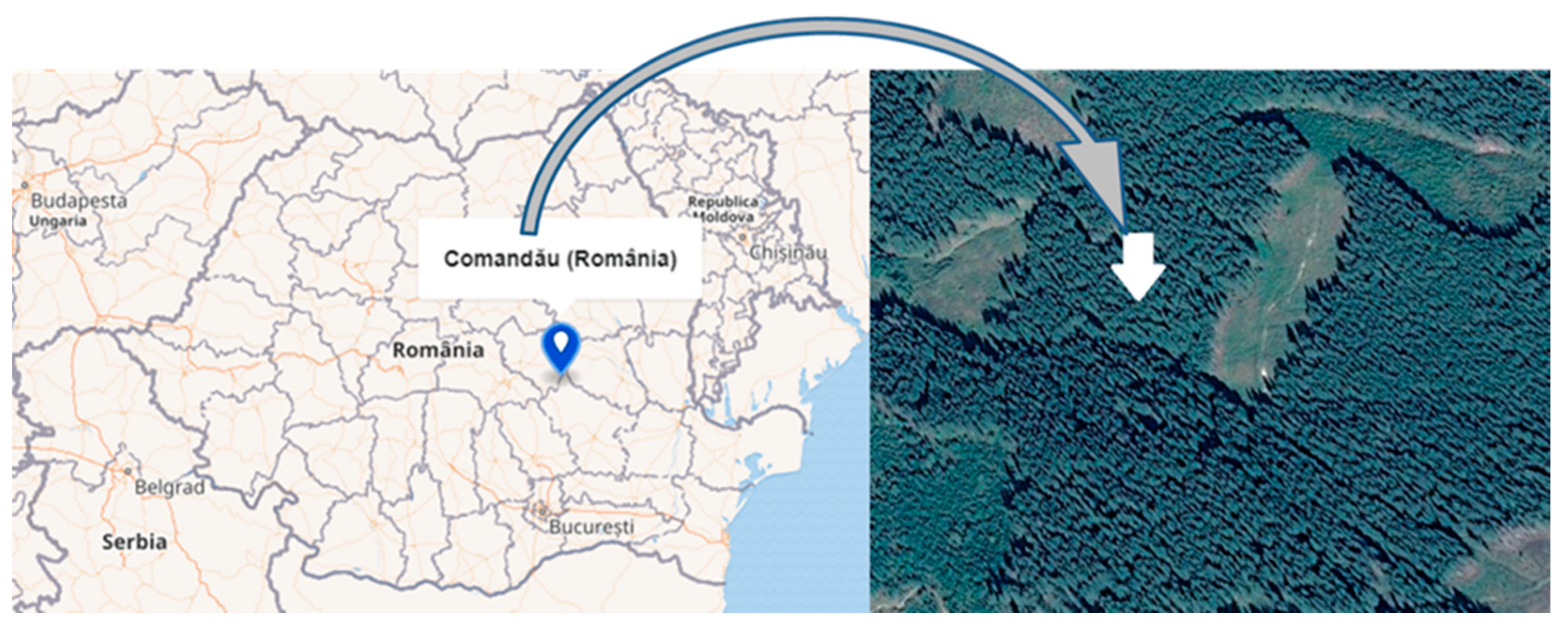
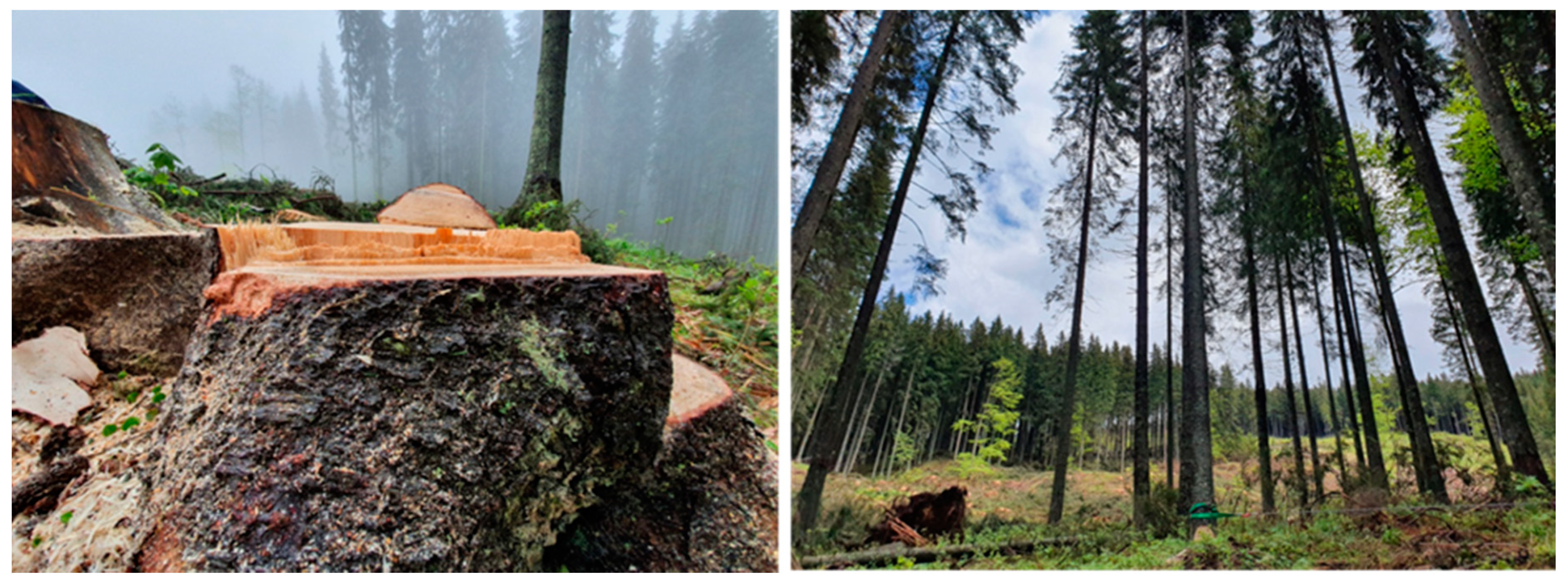
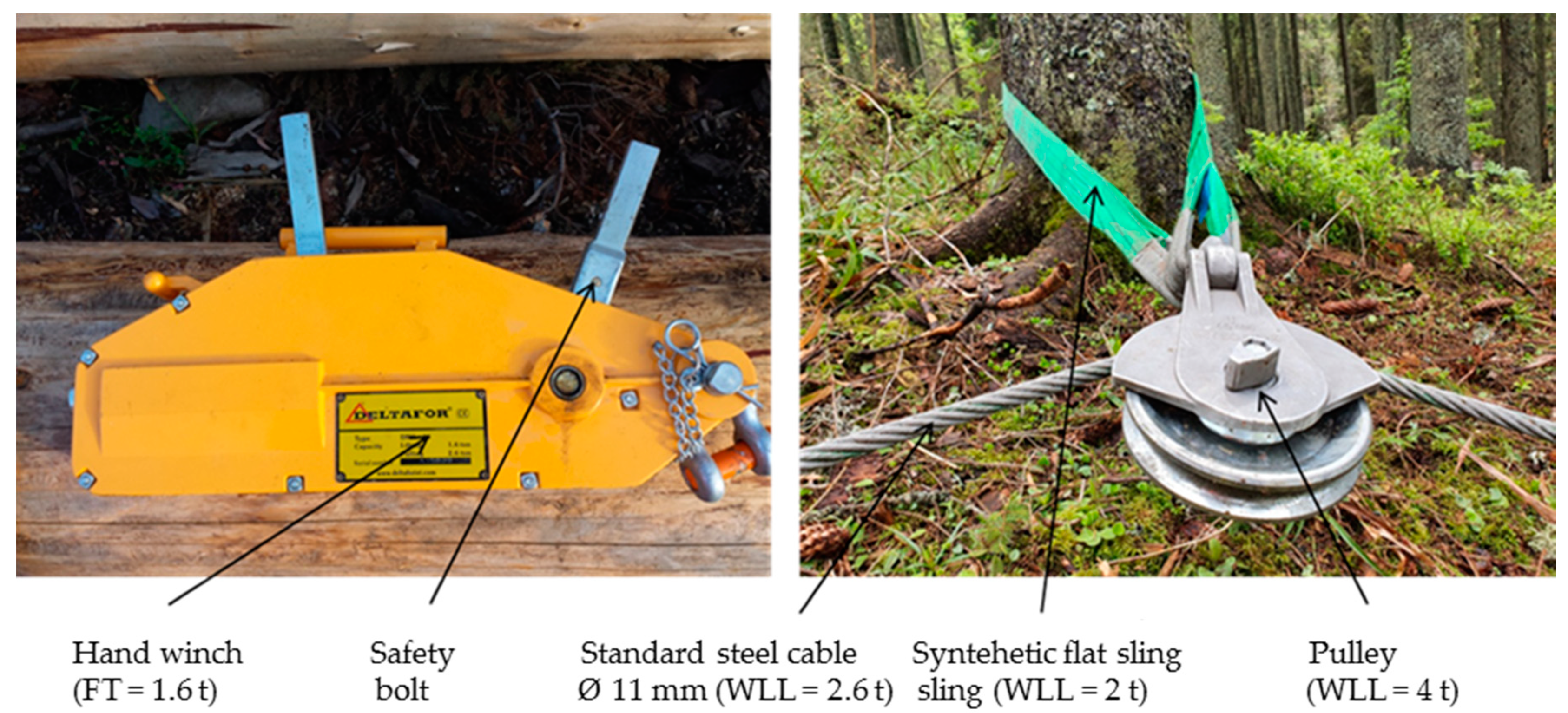
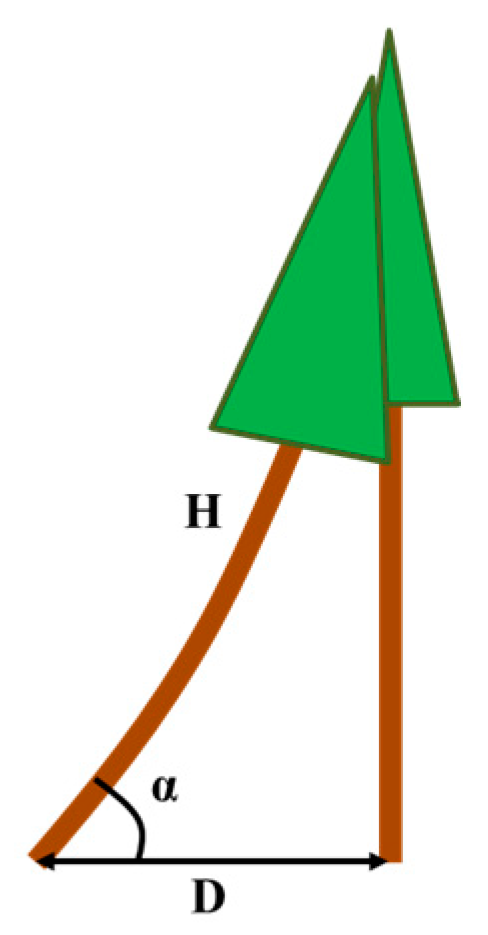
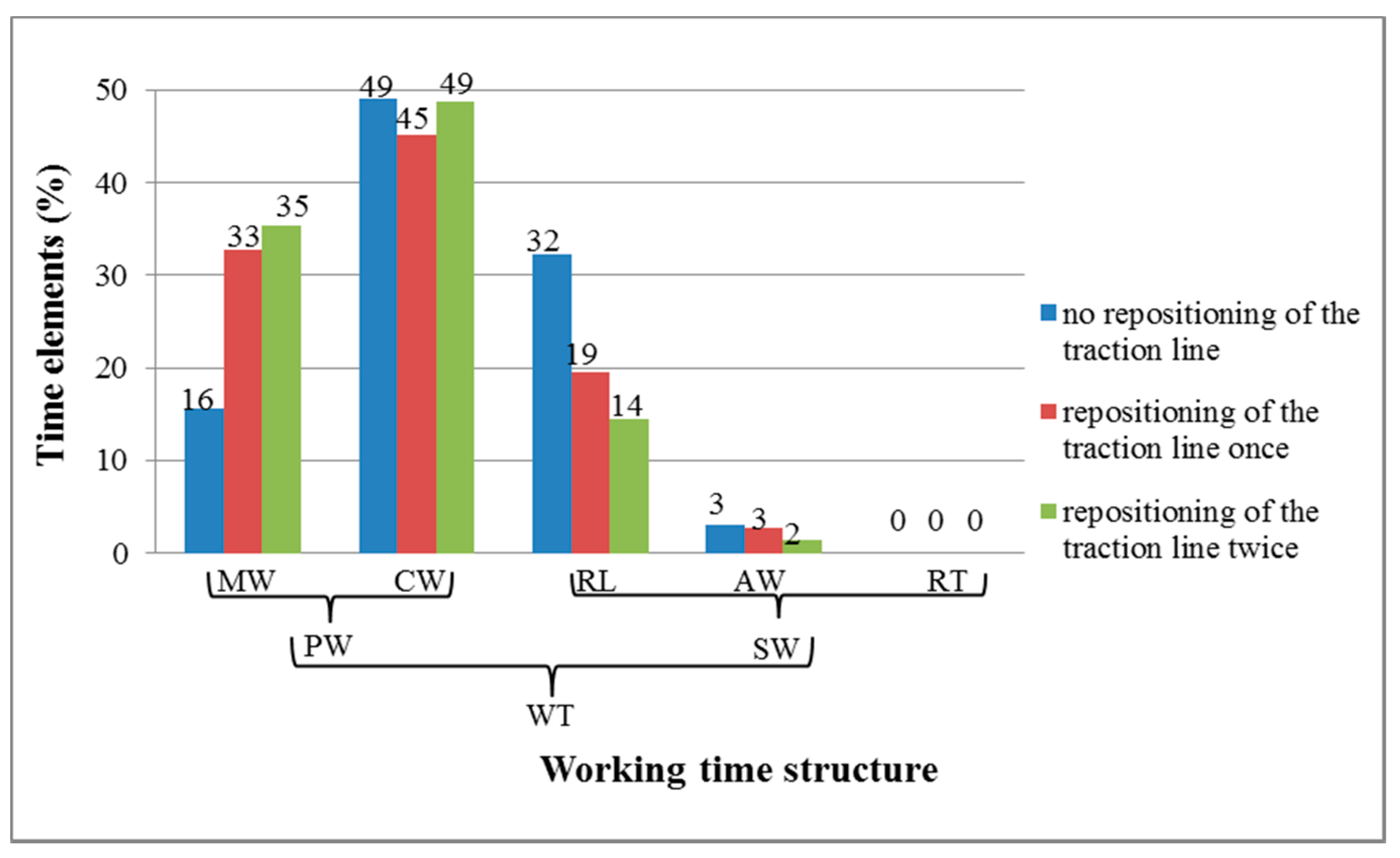
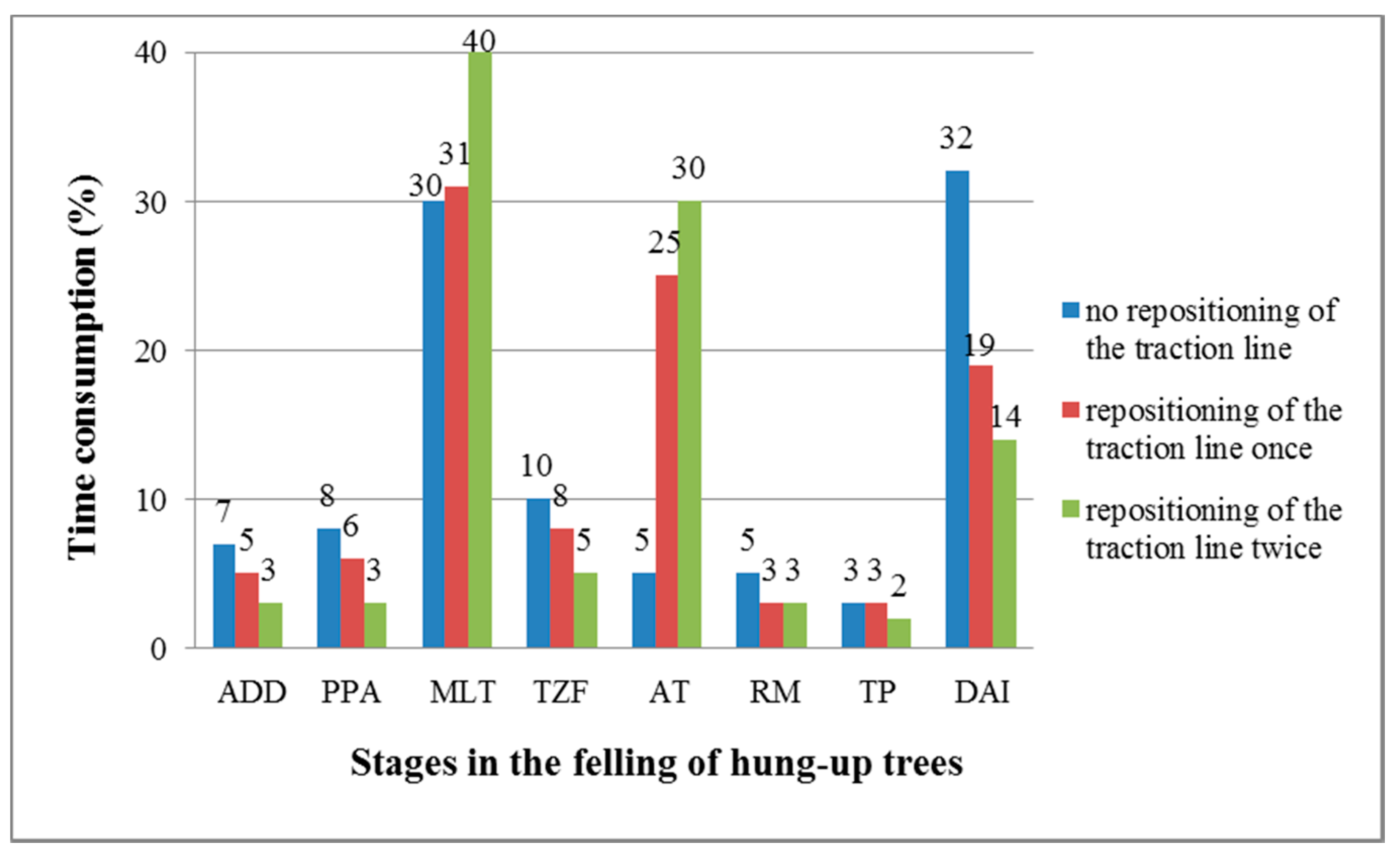
| Cutting area surface (ha) | 3.25 |
| Total volume (m3) | 1561 |
| Number of trees | 983 |
| Stand age (years) | 120 |
| Stand consistency | 0.8 |
| Pruning (%) | 60 |
| Average tree volume (m3·tree−1) | 1.59 |
| Average breast height diameter (cm) | 44 |
| Average height (m) | 28.0 |
| Stage | Symbol | Start | End |
|---|---|---|---|
| 1. Choice of the felling direction, of the work technique and of the tree rotation direction | ADD | When the main chainsaw operator starts assessing the stability of the hung up tree | When the main chainsaw operator communicates the work strategy to the secondary operator |
| 2. Preparation of anchorage points and creation of escape routes | PPA | When preparation of anchorage points starts | When chainsaw operators finished creating escape routes |
| 3. Assembling the TL | MLT | When workers start moving, in the felling area, towards the place where the TL is stored | When the traction line is tensioned in accordance with the rotation direction |
| 4. Cutting the hinge wood | TZF | When the main chainsaw operator starts to cut the hinge wood | When the chainsaw operator finalized the pivot |
| 5. Operating the hand winch | AT | When the secondary chainsaw operator starts to operate the hand winch | When the tree begins to fall |
| 6. Workers’ retreat, tree falling and workers’ come back | RM | When the tree starts to fall and workers retreat to the escape routes | When the crowns of neighboring trees calm down and workers come back near the stump |
| 7. Cutting the pivot | TP | When the main chainsaw operator starts to cut wood fibers torn from the pivot, the stump and the tree stem | When the main chainsaw operator finished cutting the pivot from the stump and the stem. |
| 8. Dismantling and packing the TL | DAI | When workers start dismantling the TL | When workers moved the TL to the storage place from the felling area |
| Working Time Structure * | Stages | Activities | |||
|---|---|---|---|---|---|
| WT | PW | MW | 4-TZF |
| |
| 5-AT |
| ||||
| CW | 1-ADD |
| |||
| 2-PPA |
| ||||
| 3-MLT |
| ||||
| 6-RM |
| ||||
| SW | PT | RL | 8-DAI |
| |
| ST | RT | - |
| ||
| AW | 7-TP |
| |||
| No. of Trees | WT According to Stages | Total WT | DBH | SD | H | LC | V | D | α | |||||||
|---|---|---|---|---|---|---|---|---|---|---|---|---|---|---|---|---|
| ADD | PPA | MLT | TZF | AT | RM | TP | DAI | |||||||||
| - | s | s | s | s | s | s | s | s | s | cm | cm | m | m | m3 | m | (˚) |
| 1 0 | 87 | 200 | 387 | 117 | 78 | 48 | 38 | 298 | 1253 | 29 | 39 | 26 | 6 | 0.793 | 5.71 | 77 |
| 2 0 | 98 | 128 | 350 | 125 | 91 | 45 | 39 | 356 | 1232 | 28 | 38 | 30 | 15.5 | 0.883 | 4.54 | 81 |
| 3 0 | 56 | 91 | 404 | 134 | 84 | 73 | 27 | 267 | 1136 | 22 | 29 | 24.5 | 11 | 0.458 | 5.78 | 76 |
| 4 0 | 63 | 124 | 301 | 121 | 100 | 62 | 50 | 276 | 1097 | 32 | 38 | 28 | 13.5 | 1.020 | 3.43 | 83 |
| 5 2 | 78 | 82 | 1025 | 127 | 780 | 67 | 38 | 371 | 2568 | 44 | 52 | 29 | 15 | 1.820 | 4.70 | 81 |
| 6 0 | 90 | 141 | 362 | 98 | 150 | 45 | 56 | 365 | 1307 | 33 | 40 | 29.5 | 15 | 1.145 | 3.55 | 83 |
| 7 0 | 78 | 99 | 345 | 105 | 96 | 67 | 45 | 376 | 1211 | 29 | 36 | 28 | 10 | 0.863 | 4.61 | 81 |
| 8 1 | 110 | 110 | 685 | 170 | 480 | 59 | 54 | 310 | 1978 | 46 | 37 | 29.5 | 14 | 1.408 | 3.95 | 82 |
| 9 0 | 68 | 64 | 312 | 95 | 24 | 59 | 34 | 320 | 976 | 32 | 39 | 24.5 | 11 | 0.874 | 5.23 | 78 |
| 10 0 | 75 | 45 | 289 | 75 | 31 | 54 | 35 | 333 | 937 | 34 | 38 | 25 | 9.5 | 0.989 | 3.59 | 82 |
| 11 0 | 54 | 129 | 296 | 76 | 15 | 48 | 39 | 354 | 1011 | 38 | 44 | 25.5 | 9 | 1.220 | 4.68 | 79 |
| 12 0 | 42 | 135 | 312 | 101 | 47 | 39 | 30 | 365 | 1071 | 32 | 38 | 26 | 11 | 0.936 | 4.63 | 80 |
| 13 0 | 59 | 35 | 298 | 125 | 22 | 50 | 20 | 345 | 954 | 37 | 42 | 28 | 14.5 | 1.303 | 4.75 | 80 |
| 14 1 | 58 | 87 | 416 | 100 | 388 | 45 | 42 | 367 | 1503 | 37 | 46 | 29.5 | 14 | 0.934 | 4.35 | 81 |
| 15 0 | 56 | 40 | 234 | 119 | 32 | 54 | 23 | 260 | 818 | 40 | 48 | 29.5 | 14.5 | 1.578 | 4.94 | 80 |
| 16 0 | 67 | 58 | 244 | 71 | 48 | 62 | 29 | 316 | 895 | 36 | 45 | 29.5 | 14 | 1.327 | 4.02 | 82 |
| 17 0 | 70 | 133 | 364 | 107 | 18 | 53 | 20 | 352 | 1117 | 39 | 46 | 32 | 16 | 1.670 | 3.95 | 83 |
| 18 0 | 55 | 48 | 288 | 97 | 30 | 45 | 25 | 355 | 943 | 36 | 42 | 28.5 | 14.5 | 1.273 | 4.65 | 81 |
| 19 0 | 73 | 106 | 259 | 108 | 40 | 48 | 22 | 299 | 955 | 28 | 38 | 27 | 8 | 0.779 | 3.76 | 82 |
| 20 0 | 68 | 45 | 267 | 131 | 34 | 52 | 25 | 329 | 951 | 38 | 52 | 28 | 12 | 1.365 | 3.96 | 82 |
| 21 0 | 57 | 40 | 245 | 90 | 65 | 46 | 28 | 367 | 938 | 28 | 34 | 27 | 9 | 0.779 | 4.87 | 80 |
| 22 0 | 67 | 54 | 275 | 78 | 38 | 39 | 29 | 378 | 958 | 31 | 38 | 27.5 | 10 | 0.958 | 4.74 | 80 |
| 23 0 | 56 | 28 | 244 | 133 | 45 | 43 | 21 | 299 | 869 | 35 | 42 | 28 | 14 | 1.187 | 5.21 | 79 |
| 24 0 | 67 | 35 | 329 | 164 | 41 | 48 | 34 | 385 | 1103 | 35 | 42 | 27.5 | 15 | 1.169 | 3.98 | 82 |
| 25 0 | 80 | 35 | 339 | 108 | 51 | 48 | 24 | 363 | 1048 | 38 | 50 | 28 | 12 | 1.365 | 3.78 | 82 |
| Total 0 | 1486 | 1813 | 6744 | 2378 | 1180 | 1128 | 693 | 7358 | 22,780 | - | - | - | - | 23.934 | - | - |
| Total 1 | 168 | 197 | 1101 | 270 | 868 | 104 | 96 | 677 | 3481 | - | - | - | - | 2.342 | - | - |
| Total 2 | 78 | 82 | 1025 | 127 | 780 | 67 | 38 | 371 | 2568 | - | - | - | - | 1.820 | - | - |
| Trees that Needed no Repositioning of TL | ||||||||||
| No. of trees | Average tree volume | WT | ||||||||
| PW | SW | |||||||||
| MW | CW | PT | ST | AW | ||||||
| RL | RT | |||||||||
| m3·tree−1 | s·m−3 | % | s·m−3 | % | s·m−3 | % | - | s·m−3 | % | |
| 22 | 1.088 | 148.66 | 15.62 | 466.74 | 49.04 | 307.42 | 32.30 | - | 28.95 | 3.04 |
| s·tree−1 | s·tree−1 | s·tree−1 | - | s·tree−1 | ||||||
| 161.73 | 507.77 | 334.45 | - | 31.50 | ||||||
| Total | s·m−3 | % | ||||||||
| 951.77 | 100 | |||||||||
| s·tree−1 | ||||||||||
| 1035.46 | ||||||||||
| Trees that Needed Repositioning of TL Once | ||||||||||
| No. of trees | Average tree volume | WT | ||||||||
| PW | SW | |||||||||
| MW | CW | PT | ST | AW | ||||||
| RL | RT | |||||||||
| m3·tree−1 | s·m−3 | % | s·m−3 | % | s·m−3 | % | - | s·m−3 | % | |
| 2 | 1.171 | 485.94 | 32.69 | 670.40 | 45.10 | 289.09 | 19.45 | - | 40.99 | 2.76 |
| s·tree−1 | s·tree−1 | s·tree−1 | - | s·tree−1 | ||||||
| 569.00 | 785.00 | 338.50 | - | 48.00 | ||||||
| Total | s·m−3 | % | ||||||||
| 1486.42 | 100 | |||||||||
| s·tree−1 | ||||||||||
| 1740.50 | ||||||||||
| Trees that Needed Repositioning of TL Twice | ||||||||||
| No. of trees | Average tree volume | WT | ||||||||
| PW | SW | |||||||||
| MW | CW | PT | ST | AW | ||||||
| RL | RT | |||||||||
| m3·tree−1 | s·m−3 | % | s·m−3 | % | s·m−3 | % | - | s·m−3 | % | |
| 1 | 1.820 | 498.29 | 35.32 | 687.83 | 48.75 | 203.82 | 14.45 | - | 20.88 | 1.48 |
| s·tree−1 | s·tree−1 | s·tree−1 | - | s·tree−1 | ||||||
| 907.00 | 1252.00 | 371.00 | - | 38.00 | ||||||
| Total | s·m−3 | % | ||||||||
| 1410.74 | 100 | |||||||||
| s·tree−1 | ||||||||||
| 2568 | ||||||||||
| Working time | Mean | Median | Minimum | Maximum | Standard Error | Standard Deviation | Variation Coefficient (%) |
|---|---|---|---|---|---|---|---|
| Statistical indicators of working time (s) corresponding to the stages in the felling of hung up trees | |||||||
| T-ADD T-PPA T-MLT T-TZF T-AT T-RM T-TP T-DAI | 67.55 82.41 306.55 108.09 53.64 51.27 31.50 334.45 | 67.00 61.00 299.50 107.50 43.00 48.00 29.00 348.50 | 42 28 234 71 15 39 20 260 | 98 200 404 164 150 73 56 385 | 2.85 10.25 10.39 4.89 7.14 1.86 2.10 8.00 | 13.39 48.06 48.74 22.96 33.51 8.72 9.83 37.51 | 19.82 58.31 15.90 21.24 62.48 17.02 31.21 11.21 |
| WT | 1035.46 | 993.5 | 818 | 1307 | 28.29 | 132.71 | 12.82 |
| Statistical indicators of V (m3), H (m), LC (%), DBH (cm), SD (cm), D (m), and α (o) | |||||||
| V SD DBH H LC | 1.088 40.82 32.95 27.61 44.32 | 1.082 39.50 33.00 28.00 44.90 | 0.458 29.00 22.00 24.50 29.63 | 1.670 52.00 40.00 32.00 54.55 | 0.061 1.13 0.99 0.40 1.56 | 0.29 5.28 4.54 1.88 7.13 | 26.71 12.93 13.79 6.80 16.09 |
| D | 4.47 | 4.62 | 3.43 | 5.78 | 0.14 | 0.68 | 15.19 |
| α | 80.59 | 81 | 76 | 83 | 0.41 | 1.92 | 2.38 |
| ANOVA | Significance of Variable Coefficient | |||||||
|---|---|---|---|---|---|---|---|---|
| R2 | Standard Error | Degrees of freedom | F | Variable | Coefficient | Standard Error | t Statistic | p–value |
| Simple linear regression analysis of WT in relation to DBH | ||||||||
| 0.19 | 122.668 | Regression 1 Residual 20 | 4.580 * | Constant | 1452.042 | 196.399 | 7.393 | - |
| DBH | −12.555 | 5.866 | −2.140 | <0.05 * | ||||
| Independent Variable | ANOVA | ||
|---|---|---|---|
| r | F | p-Value | |
| V | 0.34 | 2.620 | >0.05 |
| SD | 0.34 | 2.541 | >0.05 |
| H | 0.08 | 0.138 | >0.05 |
| LC | 0.06 | 0.074 | >0.05 |
| D | 0.02 | 0.012 | >0.05 |
Publisher’s Note: MDPI stays neutral with regard to jurisdictional claims in published maps and institutional affiliations. |
© 2020 by the authors. Licensee MDPI, Basel, Switzerland. This article is an open access article distributed under the terms and conditions of the Creative Commons Attribution (CC BY) license (http://creativecommons.org/licenses/by/4.0/).
Share and Cite
Câmpu, R.V.; Bratu, M.A.; Ciocirlan, M. The Felling of Hung Up Trees—A Work Safety and Productivity Issue. Forests 2020, 11, 1225. https://doi.org/10.3390/f11111225
Câmpu RV, Bratu MA, Ciocirlan M. The Felling of Hung Up Trees—A Work Safety and Productivity Issue. Forests. 2020; 11(11):1225. https://doi.org/10.3390/f11111225
Chicago/Turabian StyleCâmpu, Răzvan V., Mihai A. Bratu, and Mihai Ciocirlan. 2020. "The Felling of Hung Up Trees—A Work Safety and Productivity Issue" Forests 11, no. 11: 1225. https://doi.org/10.3390/f11111225




